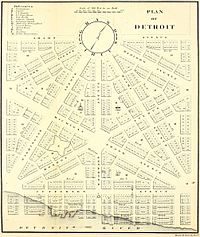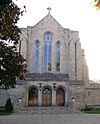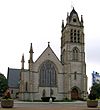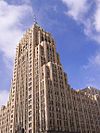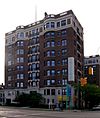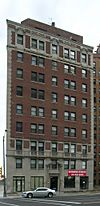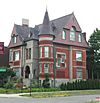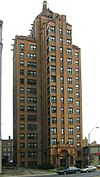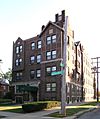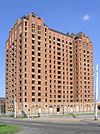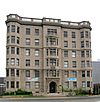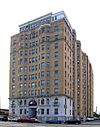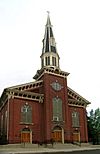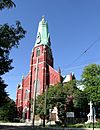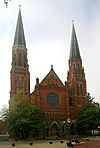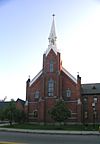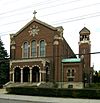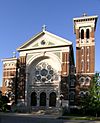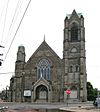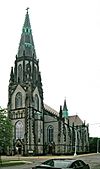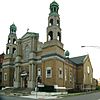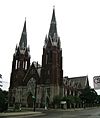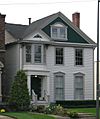National Register of Historic Places listings in Detroit facts for kids
Detroit, Michigan, is home to many amazing historic places! These places are listed on the National Register of Historic Places. This list helps protect buildings, districts, and sites that are important to American history.
Imagine a map of Detroit. This list focuses on historic spots outside the busy Downtown and Midtown areas. There are 271 such places in Detroit, including 10 that are extra special, called National Historic Landmarks. These landmarks are super important to the whole country!
Contents
Exploring Detroit's Historic Areas
The historic places on this list are found in different parts of Detroit, outside the main Downtown and Midtown areas. Think of these as different neighborhoods, each with its own history:
- New Center Area: This is just north of Midtown. It's known for big, important buildings.
- North End: Even further north than New Center.
- Palmer Park Area: This area is in the northern part of Detroit.
- Corktown – Woodbridge: Located west of Downtown, it's one of Detroit's oldest neighborhoods.
- Southwest Detroit: This is the part of Detroit west of Corktown.
- Eastern Market Area: East of Downtown, this area is famous for its lively market.
- Jefferson Corridor: This runs along Jefferson Avenue, east of Downtown.
- West Side: All the other parts of Detroit west of Woodward Avenue.
- East Side: All the other parts of Detroit east of Woodward Avenue.
Overall, there are 135 historic places listed in these outer Detroit neighborhoods. There are even more in Downtown and Midtown, which you can find on a separate list: National Register of Historic Places listings in Downtown and Midtown Detroit.
A Quick Look at Detroit's History
Detroit has a long and interesting past, full of changes and growth.
How Detroit Began
Detroit was founded way back in 1701, making it one of the oldest cities in the Midwest. A huge fire in 1805 almost destroyed everything! After the fire, a judge named Augustus B. Woodward helped design a new city plan. This plan had wide streets spreading out like spokes on a wheel, which you can still see today in the city's heart.
Even after the fire, Detroit quickly grew. By the time of the American Civil War, over 45,000 people lived here. Many of the oldest buildings still standing are homes, like the Charles Trowbridge House (built in 1826, the oldest known building in the city!). Other old buildings include Fort Wayne (1849) and churches like Saints Peter and Paul Church (1848). Sadly, some historic buildings have been torn down over the years.
Detroit's Industry and Businesses Grow
As Detroit became a center for factories and businesses, the city expanded. Many companies, like the Dry Dock Engine Works (1852) and Parke-Davis (1870s), set up shop along the Detroit River. This was great for shipping goods.
This growth created many wealthy business owners. They built beautiful homes along East Jefferson Avenue, like the Croul–Palms House (1881). Some also built grand houses north of downtown along Woodward Avenue. You can still see some of these Victorian-style homes, like the Col. Frank J. Hecker House (1888). Later, fancy apartment buildings like the Coronado Apartments (1894) became popular for middle-class families.
Wealthy residents also helped build many churches, such as the Cass Avenue Methodist Episcopal Church (1883) and the First Unitarian Church (1890).
People Come to Detroit
Detroit has always been a city of immigrants. People came from France and England early on. Later, in the 1840s, Irish immigrants settled in the Corktown neighborhood. In the early 1900s, Greeks came to Greektown, and many people from the American South (both white and African-Americans) moved here for jobs.
The city's industrial boom in the late 1800s brought even more immigrants. Germans and Polish people arrived between the 1860s and 1890s. Germans built churches like St. Joseph Catholic Church (1873) and social clubs. Polish immigrants also built many churches on the east side, like St. Albertus (1885) and Sweetest Heart Of Mary (1893).
The Birth of the Automobile Industry
Around the early 1900s, people like Henry Ford started making cars in Detroit. The city was perfect for this because it already had many factories that made tools and carriages. Early car factories, like the Ford Piquette Avenue Plant (1904), are now historic landmarks. This is where the famous Model T was first designed!
Soon, car manufacturing took over Detroit. Big companies built huge office buildings, such as the General Motors Building (1919) and the Fisher Building (1928).
How Cars Changed Detroit
The growing car industry needed lots of workers. So, many people moved to Detroit from Europe and the American South. Between 1900 and 1930, Detroit's population exploded from 265,000 to over 1.5 million! This pushed the city's boundaries outwards. Many apartment buildings were built for the new middle-class auto workers, like the Somerset Apartments (1922).
New, fancy neighborhoods also popped up further from the city center, such as Boston-Edison and Indian Village. As people spread out, new churches were built to serve these growing areas, like the Cathedral of the Most Blessed Sacrament (1913).
Cars also changed how people traveled in the city. Bridges like the Chestnut Street-Grand Trunk Railroad bridge (1929) were built to separate car and train traffic. The West Jefferson Avenue – Rouge River Bridge (1922) helped expand the Rouge River for large boats.
The wealth from the car industry also led to a building boom in downtown Detroit. Many tall skyscrapers were built, including the beautiful Art Deco Guardian Building (1928). Shopping areas, hotels, and grand movie theaters like the Fox (1928) also appeared. Important public buildings like the Detroit Public Library (1921) and the Detroit Institute of Arts (1923) were also constructed.
African-American History in Detroit
In Detroit's early years, the African-American population was small. However, the Second Baptist Church (founded in the 1830s) played a key role in the Underground Railroad, helping enslaved people escape to Canada.
The car boom in the 1900s brought many more African-Americans to Detroit. By 1917, over 30,000 black people lived in the city. Historic places like Dunbar Hospital (founded 1914) and the Ossian H. Sweet House (1925) are important reminders of the struggle against segregation. Other buildings, like the Breitmeyer-Tobin Building (1905), show the slow progress towards integration later on.
Famous Architects in Detroit
Many famous architects designed buildings in Detroit. Albert Kahn is especially well-known for his many designs in the city. He designed large factories like the Highland Park Ford Plant (1908) and important office buildings like the General Motors Building (1919) and the Fisher Building (1928). Kahn also designed homes, apartments, and churches throughout Detroit.
Current Historic Listings
Here are some of the historic places listed on the National Register in Detroit, outside the Downtown and Midtown areas.
Historic Places in Other Neighborhoods
| Name on the Register | Image | Date listed | Location | Neighborhood | Description | |
|---|---|---|---|---|---|---|
| 1 | Alden Park Towers |
(#85002933) |
8100 E. Jefferson Ave. 42°21′05″N 82°59′40″W / 42.351389°N 82.994444°W |
Jefferson Corridor | The Alden Park Towers were built in 1922. They are one of the few large apartment buildings constructed in Detroit that are still standing. | |
| 2 | Alger Theater |
(#05000719) |
16451 E. Warren Ave. 42°24′13″N 82°56′14″W / 42.403611°N 82.937222°W |
East Side | The Art Moderne Alger Theater is one of only two neighborhood theaters in Detroit that are still complete and unchanged. A group called Friends of the Alger Theater is working to fix it up and reopen it. | |
| 3 | Amity Lodge No. 335 Temple — Spiritual Israel Church and Its Army Temple |
(#14001011) |
9375 Amity St. 42°21′52″N 82°59′13″W / 42.364401°N 82.986913°W |
East Side | This building was built in 1911 for a group called the Independent Order of Odd Fellows. Later, in 1960, it became the main building for the Spiritual Israel Church and Its Army, a church mostly for African American people. | |
| 4 | Antietam Avenue Bridge |
(#00000114) |
Antietam St. over the Grand Trunk Railroad line 42°20′43″N 83°02′05″W / 42.345278°N 83.034722°W |
Eastern Market Area | The Antietam Street bridge was built in the late 1920s. It was part of a plan to separate train tracks from streets. It used to go over the Grand Trunk Railroad, which is now the Dequindre Cut. The bridge was taken down because it was no longer safe. | |
| 5 | Arden Park-East Boston Historic District |
(#82002891) |
Arden Park and E. Boston Aves. between Woodward and Oakland Aves. 42°23′19″N 83°04′49″W / 42.388611°N 83.080278°W |
North End | The Arden Park-East Boston Historic District was planned in the 1890s. It was designed with large plots of land to attract wealthy people. Some of the first residents included famous people like Frederick J. Fisher and John Francis Dodge. | |
| 6 | Assumption of the Blessed Virgin Mary Church |
(#91001020) |
13770 Gratiot Ave. 42°25′40″N 82°58′52″W / 42.427778°N 82.981111°W |
East Side | This Roman Catholic church was started in 1830 by German immigrants. It's known as the Assumption Grotto Church because of its popular grotto, built in 1881. The grotto is a copy of the Sanctuary of Our Lady of Lourdes in France. | |
| 7 | Edmund Atkinson School |
(#10000635) |
4900 E. Hildale St. 42°25′44″N 83°03′15″W / 42.428789°N 83.054067°W |
East Side | The Edmund Atkinson School was built in 1927 as an elementary school. The Detroit Public Schools closed it in 2007. It reopened as Legacy Charter Academy in 2010. | |
| 8 | John N. Bagley House |
(#85002934) |
2921 E. Jefferson Ave. 42°20′27″N 83°01′03″W / 42.340833°N 83.0175°W |
Jefferson Corridor | This two-and-a-half-story house is one of Detroit's best examples of Richardsonian Romanesque style. It's made of dark brick and brown stone, with a large roof and a tower. | |
| 9 | Belle Isle |
(#74000999) |
Detroit River 42°20′32″N 82°58′46″W / 42.342222°N 82.979444°W |
Jefferson Corridor | Belle Isle is a 982-acre island park in the Detroit River. It has a conservatory, yacht clubs, a museum, and a golf course. It is the largest island park in the United States. | |
| 10 | Boston-Edison Historic District |
(#75000965) |
Roughly bounded by Edison St., Woodward and Linwood Aves. and Glynn Ct. 42°22′54″N 83°05′50″W / 42.381667°N 83.097222°W |
North End | The Boston-Edison Historic District is a neighborhood with over 900 historic homes. Famous people like Henry Ford and James Couzens used to live here. It's one of the biggest residential historic districts in the country. | |
| 11 | Joseph Campau House |
(#85002935) |
2910 E. Jefferson Ave. 42°20′23″N 83°01′07″W / 42.339722°N 83.018611°W |
Jefferson Corridor | The Joseph Campau House is one of the oldest homes in Detroit. It was built on land that used to be part of the Joseph Campau farm. | |
| 12 | Cathedral of the Most Blessed Sacrament |
(#82002894) |
9844-9854 Woodward Ave. 42°23′18″N 83°05′06″W / 42.388333°N 83.085°W |
North End | This cathedral has been the main church for the Archdiocese of Detroit since 1938. Building started in 1913, but it took a long time to finish. The inside was done in 1930, and the towers weren't finished until 1951. | |
| 13 | Central Woodward Christian Church |
(#82002896) |
9000 Woodward Ave. 42°22′54″N 83°04′50″W / 42.381667°N 83.080556°W |
North End | This church was built in the mid-1920s. In the 1970s, the church was sold to the Little Rock Missionary Baptist Church, who still use the building today. | |
| 14 | Chateau Frontenac Apartments |
(#91000213) |
10410 E. Jefferson Ave. 42°21′47″N 82°58′43″W / 42.363056°N 82.978611°W |
Jefferson Corridor | The Chateau Frontenac was an eight-story apartment building. It had off-white terra cotta details and a green tile roof. It has since been torn down. | |
| 15 | Alexander Chene House |
(#85002936) |
2681 E. Jefferson Ave. 42°20′21″N 83°01′17″W / 42.339167°N 83.021389°W |
Jefferson Corridor | The Chene House was a rare example of Federal architecture in Detroit. It was built in 1850 on land given to the Chene family by Louis XIV in 1707. The house was torn down in 1991. | |
| 16 | Chestnut Street-Grand Trunk Railroad |
(#00000115) |
Chestnut St. over Grand Trunk Railroad 42°20′41″N 83°02′03″W / 42.344722°N 83.034167°W |
Eastern Market Area | The Chestnut Street bridge was built in the late 1920s as part of Detroit's plan to separate train tracks from streets. It goes over what used to be the Grand Trunk Railroad, now called the Dequindre Cut. | |
| 17 | Christ Church, Detroit |
(#71000423) |
960 E. Jefferson Ave. 42°19′57″N 83°02′05″W / 42.3325°N 83.034722°W |
Jefferson Corridor | This Episcopalian church, built in 1863, is the oldest Protestant church in Michigan still on its original site. It's built in an American Gothic style with limestone. The church has beautiful Tiffany windows. | |
| 18 | Elizabeth Cleveland Intermediate School |
(#15000702) |
13322 Conant St. 42°24′44″N 83°03′29″W / 42.412332°N 83.058020°W |
East Side | This school, designed by Donaldson and Meier, is a great example of Collegiate Gothic style. It was a Detroit Public School until 2009 and now houses the Frontier International Academy. | |
| 19 | Thomas M. Cooley High School |
(#10000651) |
15055 Hubbell St. 42°24′02″N 83°11′28″W / 42.400461°N 83.191217°W |
West Side | This three-story, Mediterranean Revival school opened in 1928. It was named after Michigan Supreme Court chief justice Thomas M. Cooley. The school closed in 2010. | |
| 20 | Corktown Historic District |
(#78001517) |
Roughly bounded by Lodge Freeway, Porter, Trumbull, Bagley, Rosa Parks Boulevard, and Michigan Ave. 42°19′46″N 83°04′27″W / 42.329444°N 83.074167°W |
Corktown – Woodbridge | Corktown is Detroit's oldest neighborhood that is still standing, dating back to the 1850s. It got its name from the Irish immigrants who settled there, many of whom were from County Cork. | |
| 21 | Crescent Brass and Pin Company Building |
(#03000067) |
5766 Trumbull Ave. 42°21′32″N 83°04′56″W / 42.358889°N 83.082222°W |
West Side | This building was first built in 1905 for a company that made radiator parts. It was expanded several times. The company stopped working in Detroit in the 1980s. Now, the building has been turned into apartments called the Research Lofts on Trumbull. | |
| 22 | Croul-Palms House |
(#83003790) |
1394 E. Jefferson Ave. 42°20′01″N 83°01′55″W / 42.333611°N 83.031944°W |
Jefferson Corridor | The Croul-Palms House is named after its first two owners, Jerome Croul and Francis Palms. It's a great example of Queen Anne architecture. | |
| 23 | Edwin Denby High School |
(#04001581) |
12800 Kelly Rd. 42°25′33″N 82°57′26″W / 42.425833°N 82.957222°W |
East Side | Denby High School is named after Edwin C. Denby, a lawyer and former Secretary of the Navy. The Art Deco building has cool nautical (boat-themed) designs. | |
| 24 | Detroit Naval Armory |
(#94000662) |
7600 E. Jefferson Ave. 42°20′55″N 82°59′51″W / 42.348611°N 82.9975°W |
Jefferson Corridor | The Detroit Naval Armory was built as a training place for Michigan's "naval militias." During the Great Depression, many artworks were added to the armory. It has the largest collection of federally funded artwork from that time in Michigan. | |
| 25 | Detroit Yacht Club |
(#11000309) |
1 Riverbank Rd., Belle Isle 42°20′56″N 82°58′25″W / 42.348889°N 82.973611°W |
Jefferson Corridor | The Detroit Yacht Club is the biggest yacht club in the United States. Its clubhouse was designed in a Mediterranean Revival style. | |
| 26 | Duane Doty School |
(#10000654) |
10225 3rd St. 42°23′12″N 83°05′33″W / 42.386594°N 83.092406°W |
North End | The Duane Doty School was built in 1908. It was named after a former Superintendent of Schools for Detroit. | |
| 27 | Dry Dock Engine Works-Detroit Dry Dock Company Complex |
(#09000680) |
1801–1803 and 1900 Atwater St. 42°19′59″N 83°01′37″W / 42.333056°N 83.026944°W |
Jefferson Corridor | This complex includes six buildings and a dry dock along the river. These are what's left of a busy shipbuilding industry. The machine shop is important because it's an early industrial building made with a steel frame. | |
| 28 | East Grand Boulevard Historic District |
(#99001468) |
E. Grand Boulevard, between E. Jefferson Ave. and Mack Ave. 42°21′12″N 83°00′22″W / 42.353333°N 83.006111°W |
Jefferson Corridor | The East Grand Boulevard Historic District has several apartment buildings and many large homes. Most were built between 1900 and 1925. | |
| 29 | Eastern Market Historic District |
(#78001518) |
Bounded by Gratiot Ave., Riopelle, Rivard, and Division Sts.; also roughly bounded by Gratiot Ave., Riopelle St., Wilkins St., the Grand Trunk Railroad line, and Division St. 42°20′44″N 83°02′22″W / 42.345556°N 83.039444°W |
Eastern Market Area | Eastern Market, started in the 1850s, is the largest historic public market district in the United States. It has businesses that sell and prepare food, as well as market sheds. | |
| 30 | Eastside Historic Cemetery District |
(#82000550) |
Bounded by Elmwood and Mt. Elliot Aves., Lafayette and Waterloo Sts. 42°20′59″N 83°01′05″W / 42.349722°N 83.018056°W |
Jefferson Corridor | This district has three cemeteries: Mount Elliott Cemetery (Catholic, 1841), Elmwood Cemetery (Protestant, 1846), and Lafayette Street Cemetery (Jewish, 1850). They cover 150 acres and are known for their monuments and beautiful landscaping. | |
| 31 | Eighth Precinct Police Station |
(#74001001) |
4150 Grand River 42°20′42″N 83°04′46″W / 42.345°N 83.0795°W |
Corktown – Woodbridge | The Eighth Precinct Police Station is the second-oldest police building in Detroit. It has two two-story buildings connected by an archway. The main building was for offices, and the other was a garage. It now houses Phoenix Group Consultants. | |
| 32 | El Tovar Apartments |
(#91000214) |
320 E. Grand Boulevard 42°21′12″N 83°00′20″W / 42.353333°N 83.005556°W |
Jefferson Corridor | The 73-apartment El Tovar building is a great example of Spanish Moorish/Art Deco style. It's part of the East Grand Boulevard Historic District. | |
| 33 | Engine House No. 11 |
(#78001519) |
2737 Gratiot Ave. 42°21′16″N 83°01′53″W / 42.354444°N 83.031389°W |
East Side | Engine House No. 11 is the oldest fire station still standing in Detroit. It started in 1884 with horse-drawn equipment and switched to motorized equipment in 1911. It was used as a fire station until 1972. | |
| 34 | Engine House No. 18 |
(#95001368) |
3812 Mt. Elliott Ave. 42°21′47″N 83°01′21″W / 42.363056°N 83.0225°W |
East Side | Engine House No. 18 is the third oldest existing fire station in Detroit, and the oldest one still in use. It was built in 1892. | |
| 35 | First Baptist Church of Detroit |
(#82002898) |
8601 Woodward Ave. 42°22′44″N 83°04′47″W / 42.378889°N 83.079722°W |
North End | The First Baptist Church congregation was founded in 1827. This building was built in 1910. In 1957, First Baptist sold the building to the Peoples Community Church, who are still there. | |
| 36 | Fisher and New Center Buildings |
(#80001922) |
7430 2nd Ave. and 3011 W. Grand Boulevard 42°22′11″N 83°04′39″W / 42.369722°N 83.0775°W |
New Center Area | The Fisher and New Center Buildings are a pair of architecturally important buildings. They show some of the best craftsmanship in Art Deco style. Both were paid for by the Fisher brothers and designed by Albert Kahn. The New Center building is now called the Albert Kahn Building. | |
| 37 | Fisher Building |
(#07000847) |
3011 West Grand Boulevard 42°22′09″N 83°04′37″W / 42.369028°N 83.076922°W |
New Center Area | Built in 1927 by the Fisher brothers, this skyscraper is one of the greatest works by architect Albert Kahn. It's an Art Deco masterpiece and one of the most detailed commercial buildings in the United States. | |
| 38 | Henry Ford Hospital |
(#13000671) |
2799 West Grand Boulevard 42°22′02″N 83°05′03″W / 42.367120°N 83.084204°W |
West Side | Henry Ford Hospital opened in 1915, largely thanks to Henry Ford. The main hospital building dates from 1917. | |
| 39 | Ford Piquette Avenue Plant |
(#02000041) |
461 Piquette Ave. 42°22′07″N 83°03′56″W / 42.368611°N 83.065556°W |
New Center Area | The Ford Piquette Avenue Plant was built by the Ford Motor Company in 1904. This is where the Model T was designed and first built. Ford moved out in 1910. It is now a museum called the Model T Automotive Heritage Complex. | |
| 40 | Fort Street–Pleasant Street and Norfolk & Western Railroad Viaduct |
(#00000116) |
Fort St. over Pleasant St. and the Norfolk Southern railroad line 42°17′04″N 83°08′54″W / 42.284444°N 83.148333°W |
Southwest Detroit | This Fort Street bridge was the largest project in the 1920s plan to separate streets and train lines. Fort Street was a "superhighway" then, so the bridge had to be 80 feet wide. | |
| 41 | Fort Wayne |
(#71000425) |
6053 W. Jefferson Ave. 42°17′49″N 83°05′45″W / 42.296944°N 83.095833°W |
Southwest Detroit | Fort Wayne is Detroit's third fort. The original fort and barracks were built in 1845-48. It was used as a military post from the American Civil War through the Vietnam War. | |
| 42 | Garden Court Apartments |
(#85002937) |
2900 E. Jefferson Ave. 42°20′22″N 83°01′09″W / 42.339444°N 83.019167°W |
Jefferson Corridor | The Garden Court Apartments were built for J. Harrington Walker in 1915. The nine-story building originally had 32 very large luxury apartments. | |
| 43 | James A. Garfield School |
(#84001857) |
840 Waterman St. 42°18′23″N 83°06′33″W / 42.306389°N 83.109167°W |
Southwest Detroit | The James A. Garfield School is one of Detroit's oldest schools still standing. It was designed in 1896 and named after President James A. Garfield. | |
| 44 | General Motors Building |
(#78001520) |
3044 W. Grand Boulevard 42°22′07″N 83°04′32″W / 42.368611°N 83.075556°W |
New Center Area | The 15-story General Motors Building was designed in 1919 by Albert Kahn. It was the headquarters of General Motors Corporation until 1996. Now called Cadillac Place, it's used by the State of Michigan. | |
| 45 | General Motors Research Laboratory |
(#05000713) |
485-495 Milwaukee 42°22′05″N 83°04′30″W / 42.368056°N 83.075°W |
New Center Area | This building, designed by Albert Kahn, was a laboratory for General Motors. General Motors recently gave it to Detroit's College for Creative Studies. It's also known as the Argonaut Building. | |
| 46 | Gethsemane Evangelical Lutheran Church |
(#82002900) |
4461 28th St. 42°20′16″N 83°06′36″W / 42.337778°N 83.11°W |
West Side | The Gethsemane Lutheran Church is a wooden, High Victorian Gothic chapel, built in 1891. The building was bought by the Motor City Missionary Baptist Church in 1978. | |
| 47 | Grand Riviera Theater |
(#82002901) |
9222 Grand River Ave. 42°21′58″N 83°07′51″W / 42.366111°N 83.130833°W |
West Side | The Grand Riviera was built in 1925 and cost over a million dollars. It could seat over three thousand people. It was the first "atmospheric" theater in Detroit, making the audience feel like they were sitting outdoors. It was torn down in 1997. | |
| 48 | Greenfield Union School |
(#10000662) |
420 W. 7 Mile Rd. 42°25′57″N 83°06′28″W / 42.4325°N 83.107778°W |
Palmer Park Area | The Greenfield Union School was built for $40,000 in 1914. In 1916, the area became part of Detroit. | |
| 49 | Hibbard Apartment Building |
(#85002938) |
8905 E. Jefferson Ave. 42°21′26″N 82°59′14″W / 42.357222°N 82.987222°W |
Jefferson Corridor | The Hibbard Apartment Building is a nine-story building with 40 apartments. It was designed in a beautiful Renaissance Revival style by Robert O. Derrick. | |
| 50 | Hook and Ladder House No. 5-Detroit Fire Department Repair Shop |
(#97001481) |
3400-3434 Russell 42°21′04″N 83°02′35″W / 42.351111°N 83.043056°W |
Eastern Market Area | These are two connected buildings originally built for the Detroit Fire Department. The Hook and Ladder House was built in 1888, and the Repair Shop in 1917. They are now a restaurant and apartments. | |
| 51 | Hunter House |
(#74001002) |
3985 Trumbull Ave. 42°20′43″N 83°04′30″W / 42.345278°N 83.0750°W |
Corktown – Woodbridge | This home was built in 1891 for William Northwood. In the 1960s, it was a church. In the 1970s, the Hunter family bought it and turned it back into a home. It's now a bed and breakfast. | |
| 52 | Hurlbut Memorial Gate |
(#75000967) |
E. Jefferson at Cadillac Boulevard 42°21′39″N 82°58′53″W / 42.360833°N 82.981389°W |
Jefferson Corridor | Hurlbut Memorial Gate is named after Chauncey Hurlbut, a Detroit water commissioner. It marks the entrance to Waterworks Park, where Detroit's water system is located. The gate is a beautiful Beaux Arts design made of limestone. | |
| 53 | Indian Village Historic District |
(#72000667) |
Bounded by Mack, Burns, Jefferson, and Seminole Aves. 42°21′40″N 82°59′48″W / 42.361111°N 82.996667°W |
Jefferson Corridor | Indian Village has many architecturally important homes built in the early 1900s. Many were designed by famous architects like Albert Kahn for important citizens like Edsel Ford. | |
| 54 | Jefferson Hall |
(#85002939) |
1404 E. Jefferson Ave. 42°20′06″N 83°01′50″W / 42.335°N 83.030556°W |
Jefferson Corridor | Jefferson Hall was a four-story apartment building with apartments arranged around a central courtyard. It has been torn down. | |
| 55 | Jefferson-Chalmers Historic Business District |
(#04000598) |
E. Jefferson between Eastlawn and Alter 42°22′26″N 82°56′34″W / 42.373889°N 82.942778°W |
Jefferson Corridor | The Historic Jefferson-Chalmers Business District is one of the few early 20th-century neighborhood business areas that still exist in Detroit. It runs for eight blocks along Jefferson Avenue. | |
| 56 | The Kean |
(#85002940) |
8925 E. Jefferson Ave. 42°21′27″N 82°59′12″W / 42.3575°N 82.986667°W |
Jefferson Corridor | The Kean is a striking Art Deco apartment building designed in 1931. It is sixteen stories high and was the last large apartment building built along East Jefferson before the Great Depression slowed down construction. | |
| 57 | Kingston Arms Apartments |
(#99000433) |
296 E. Grand Boulevard 42°21′16″N 83°00′28″W / 42.354444°N 83.007778°W |
Jefferson Corridor | The Kingston Arms is a four-and-a-half-story apartment building with 24 apartments. It shows how middle-class apartment buildings became popular in Detroit before the Great Depression. It is in the East Grand Boulevard Historic District. | |
| 58 | Lee Plaza Hotel |
(#81000319) |
2240 W. Grand Boulevard 42°21′34″N 83°06′06″W / 42.359444°N 83.101667°W |
West Side | First built as a fancy high-rise hotel, Lee Plaza offered upscale apartments with hotel services. It was known for its sculptures and tiles on the outside. The building is currently empty. | |
| 59 | Nellie Leland School |
(#02000044) |
1395 Antietam St. 42°20′28″N 83°02′15″W / 42.341111°N 83.0375°W |
Eastern Market Area | The Nellie Leland School was built to serve children with disabilities. It is named after the wife of Henry M. Leland, a Detroit car pioneer who founded Cadillac and Lincoln. | |
| 60 | Manchester Apartments |
(#85002941) |
2016 E. Jefferson Ave. 42°20′10″N 83°01′37″W / 42.336111°N 83.026944°W |
Jefferson Corridor | The Manchester Apartments are a typical example of middle-class apartment buildings built in Detroit in the early 1900s. Its exterior details show the rise of modern design. | |
| 61 | Metropolitan United Methodist Church |
(#82002904) |
8000 Woodward Ave. 42°22′29″N 83°04′32″W / 42.374722°N 83.075556°W |
New Center Area | The Metropolitan United Methodist Church was founded in 1901. The church building was constructed in 1922 on land given by Sebastian S. Kresge. By the mid-1930s, it was the largest local Methodist church in the world. | |
| 62 | Michigan Bell and Western Electric Warehouse |
(#09001069) |
882 Oakman Boulevard 42°24′10″N 83°06′48″W / 42.402692°N 83.113256°W |
North End | This building was constructed in 1929-30 as a warehouse, garage, and office for Western Electric. It was later used by Michigan Bell until 1999. | |
| 63 | Michigan State Fair Riding Coliseum, Dairy Cattle Building, and Agricultural Building |
(#80001925) |
Michigan State Fairgrounds 42°26′36″N 83°07′03″W / 42.443333°N 83.1175°W |
Palmer Park Area | These three buildings are on the grounds of the Michigan State Fair. They were built between 1922 and 1926. All three look similar, with a Neo-Classical Revival style, white stucco, and red brick foundations. | |
| 64 | Mies van der Rohe Residential District, Lafayette Park |
(#96000809) |
Roughly bounded by Lafayette Ave., Rivard, Antietam, and Orleans Sts. 42°20′31″N 83°02′08″W / 42.341944°N 83.035556°W |
Jefferson Corridor | This 78-acre project was designed by Mies van der Rohe and others. It has the largest collection of his work in the world. The apartment buildings are classic examples of Mies' International Style, known for their simple, clean look. | |
| 65 | Sidney D. Miller Junior High and High School |
(#10000689) |
2322 DuBois St. 42°20′54″N 83°01′54″W / 42.348272°N 83.031711°W |
East Side | Miller Middle School opened in 1921. It became a high school in 1933, serving mostly African-American students. In 1957, it went back to being a middle school and closed in 2007. | |
| 66 | Moross House |
(#72000669) |
1460 E. Jefferson Ave. 42°20′05″N 83°01′53″W / 42.334722°N 83.031389°W |
Jefferson Corridor | The Moross House was built in the 1840s by brickmaker Christopher Moross. It is the oldest brick house still standing in Detroit. | |
| 67 | Nacirema Club |
(#11000867) |
6118 30th St. 42°20′59″N 83°06′58″W / 42.349722°N 83.116111°W |
West Side | The Nacirema Club, founded in 1922, was the first African-American social club in Michigan. It was a very important social center for the neighborhood. The name "Nacirema" is "American" spelled backwards! | |
| 68 | New Amsterdam Historic District |
(#01000570) |
435, 450 Amsterdam;440, 41-47 Burroughs; 5911-5919, 6050-6160 Cass; 6100-6200 Second; 425 York 42°21′56″N 83°04′21″W / 42.365556°N 83.0725°W |
New Center Area | The New Amsterdam Historic District has a mix of factories, businesses, and government buildings. Most were built around the early 1900s. The area grew because of major railroad lines built in the 1890s. The original Cadillac assembly plant is in this district. | |
| 69 | New Center Commercial Historic District |
(#16000218) |
Woodward Ave.-Baltimore St. to Grand Blvd. 42°22′10″N 83°04′22″W / 42.369322°N 83.072658°W |
New Center Area | This district has fourteen important buildings, built from the late 1880s to 1942. They are one to three-story commercial buildings in different styles like Art Deco. This area has kept more of its business life than many other neighborhood commercial districts. | |
| 70 | Philetus W. Norris House |
(#91001982) |
17815 Mt. Elliott Ave. 42°25′30″N 83°02′19″W / 42.425°N 83.038611°W |
East Side | The Philetus W. Norris House was built in 1873 by Philetus W. Norris. He later became the second superintendent of Yellowstone National Park. His house is one of the few original buildings left in the area. | |
| 71 | North Woodward Congregational Church |
(#82002905) |
8715 Woodward Ave. 42°22′47″N 83°04′49″W / 42.379722°N 83.080278°W |
North End | The North Woodward Congregational Church was built in stages, starting in 1907. The main part was built in 1911–1912. The building was sold to St. John's Christian Methodist Episcopal Church in the 1950s. | |
| 72 | Palmer Park Apartment Building Historic District |
(#83000895) |
Roughly bounded by Pontchartrain Boulevard, McNichols Rd. and Covington Dr.; also approximately bounded by Covington Dr., Pontchartrain Boulevard, Woodward Ave., and W. McNichols Rd. 42°25′11″N 83°06′37″W / 42.419722°N 83.110278°W |
Palmer Park Area | This historic district was once the estate of Thomas W. Palmer. In 1925, Walter Briggs hired Albert Kahn to design an apartment building here. Forty buildings were built in the district by many architects, mostly between the 1920s and 1930s. | |
| 73 | Palmer Woods Historic District |
(#83000896) |
Roughly bounded by Seven Mile Rd., Woodward Ave., and Strathcona Dr. 42°26′05″N 83°07′28″W / 42.434722°N 83.124444°W |
Palmer Park Area | Palmer Woods Historic District is named after Thomas W. Palmer, a famous Detroit citizen. The neighborhood was planned in the mid-1910s. A landscape architect designed the area with curving streets and a park-like feel. | |
| 74 | The Palms |
(#85002942) |
1001 E. Jefferson Ave. 42°20′00″N 83°02′04″W / 42.333333°N 83.034444°W |
Jefferson Corridor | The Palms was one of the first buildings in the US to use reinforced concrete. It was named after Francis Palms, a major investor. The apartments were very large and luxurious. | |
| 75 | Parke-Davis and Company Pharmaceutical Company Plant |
(#85002445) |
Bounded by Joseph Campau Ave., Wight St., and McDougal Ave. 42°20′13″N 83°00′59″W / 42.336944°N 83.016389°W |
Jefferson Corridor | In the 1870s, Parke-Davis moved to this riverfront property. Between 1891 and 1955, the company built 26 buildings here, including the Parke-Davis Research Laboratory. These buildings show different styles from the early 1900s. It's also known as Stroh River Place. | |
| 76 | Parke-Davis Research Laboratory |
(#76001039) |
Joseph Campau St. at Detroit River 42°20′13″N 83°00′52″W / 42.336944°N 83.014444°W |
Jefferson Corridor | Built in 1902, this was the first industrial research laboratory in the U.S. specifically for pharmacological research. It started the idea of companies doing pure science research to create new products. It's now called the Omni Detroit Hotel at River Place. | |
| 77 | Arthur M. Parker House |
(#85002943) |
8115 E. Jefferson Ave. 42°21′10″N 82°59′36″W / 42.352778°N 82.993333°W |
Jefferson Corridor | The Arthur M. Parker House is a two-and-a-half-story house. It has a medieval look with brick, stucco, and half-timbering. | |
| 78 | Thomas A. Parker House |
(#82000552) |
975 E. Jefferson Ave. 42°19′59″N 83°02′06″W / 42.333056°N 83.035°W |
Jefferson Corridor | Thomas Parker, a grocer, had this house built in 1868. It's a rare example of a Gothic Revival house in Detroit. | |
| 79 | Pasadena Apartments |
(#85002944) |
2170 E. Jefferson Ave. 42°20′12″N 83°01′34″W / 42.336667°N 83.026111°W |
Jefferson Corridor | This building is an early example of fancy, multi-unit housing. It was one of the first buildings of its kind built with reinforced concrete. It was constructed when many new wealthy families were appearing in Detroit. | |
| 80 | Penn Central Station |
(#75000969) |
2405 W. Vernor St. 42°19′42″N 83°04′41″W / 42.328333°N 83.078056°W |
Corktown – Woodbridge | This building started as Detroit's main train station in 1913. It was part of a bigger project that included a tunnel under the Detroit River. The building was used for train service until 1988 and is now empty. | |
| 81 | Pewabic Pottery |
(#71000430) |
10125 E. Jefferson Ave. 42°21′41″N 82°58′54″W / 42.361389°N 82.981667°W |
Jefferson Corridor | This 1907 building is the home of ceramic artist Mary Chase Perry Stratton's studio. Her work in the Arts and Crafts movement made American pottery more artistic. Her pottery is in many famous buildings. | |
| 82 | Pilgrim and Puritan Apartment Complex |
(#14000514) |
9303–9333 E. Jefferson Ave. 42°21′34″N 82°59′04″W / 42.359492°N 82.984420°W |
Jefferson Corridor | Designed in 1924, these two apartment buildings provided homes for Detroit's growing professional and middle-class families. They were built when the area was developing with luxury apartments. | |
| 83 | Piquette Avenue Industrial Historic District |
(#04000601) |
Roughly bounded by Woodward, Harper, Hastings and the Grand Trunk Western Railroad Line 42°22′05″N 83°03′57″W / 42.368056°N 83.065833°W |
New Center Area | The area along Piquette was a key place for making cars in the early 1900s. Companies like Ford Motor Company, Studebaker, and Cadillac had factories here. In 1911, the two biggest car makers, Studebaker and Ford, were next door to each other on Piquette. | |
| 84 | The Players |
(#87000920) |
3321 E. Jefferson Ave. 42°20′32″N 83°00′51″W / 42.342222°N 83.014167°W |
Jefferson Corridor | The Players Club of Detroit was started in 1910 by local businessmen to support amateur theater. In 1925, a member designed this building for the club. It was built using a new material at the time: cinder blocks. | |
| 85 | Ponchartrain Apartments |
(#85002945) |
1350 E. Jefferson Ave. 42°20′02″N 83°01′55″W / 42.333889°N 83.031944°W |
Jefferson Corridor | The Ponchartrain Apartment building was a four-story red brick building. It has been torn down. | |
| 86 | Redford Theatre Building |
(#85000171) |
17354 Lahser Ave. 42°25′02″N 83°15′27″W / 42.417222°N 83.2575°W |
West Side | The Redford Theatre opened in 1928 and has been open ever since. Its original pipe organ is still there and works! | |
| 87 | Louis G. Redstone Residential Historic District |
(#14000024) |
19303, 19309, and 19315 Appoline St. 42°26′00″N 83°10′20″W / 42.433285°N 83.172159°W |
West Side | This district has three houses designed by architect Louis G. Redstone for himself, his brother, and his business partner. The houses show features of the International Style, like low roofs and corner windows. | |
| 88 | River Terrace Apartments |
(#09000204) |
7700 E. Jefferson St. 42°20′59″N 82°59′49″W / 42.34959°N 82.99695°W |
Jefferson Corridor | The River Terrace Apartments were built in 1939 for middle-class residents. It was one of the first apartment complexes in Michigan to get loan help from the Federal Housing Administration. | |
| 89 | Rosedale Park Historic District |
(#06000587) |
Roughly bounded by Fenkell, Outer Dr. W, Grand River Ave., the Southfield Freeway, Glastonbury, Lyndon, Westwood Dr., 42°24′01″N 83°13′37″W / 42.400278°N 83.226944°W |
West Side | Most houses in Rosedale Park were built in the 1920s and late 1930s/early 1940s. They were built in many styles, like English Tudor revival and Colonial Revival. Many homes have English Tudor details, giving the neighborhood a country feel. | |
| 90 | Sacred Heart Roman Catholic Church, Convent and Rectory |
(#80001926) |
1000 Eliot St. 42°21′03″N 83°02′47″W / 42.350833°N 83.046389°W |
Eastern Market Area | Sacred Heart, built in 1875, was the third German Roman Catholic church in Detroit. In 1938, it became an African American parish. The church had a school that graduated its first high school class in 1945. | |
| 91 | Sacred Heart Seminary |
(#82000553) |
2701 W. Chicago Boulevard 42°22′28″N 83°06′41″W / 42.374444°N 83.111389°W |
West Side | Sacred Heart Major Seminary is a Catholic college. The seminary building was built in 1923 in the English Tudor Gothic style. It has stained glass windows designed by Margaret Bouchez Cavanaugh. | |
| 92 | St. Albertus Roman Catholic Church |
(#78001522) |
4231 St. Aubin St. 42°21′36″N 83°02′31″W / 42.36°N 83.041944°W |
East Side | In 1871, St. Albertus Parish was started with about three hundred Polish families. A wooden church was built in 1872. The parish grew a lot, and construction on the current building began in 1882. | |
| 93 | Ste. Anne Roman Catholic Church Complex |
(#76001040) |
Howard and Ste. Anne Sts. 42°19′15″N 83°04′36″W / 42.320833°N 83.076667°W |
Southwest Detroit | Ste. Anne de Detroit, founded in 1701, is the second oldest continuously operating Roman Catholic parish in the United States. The current church was built in 1886. Today, the church has a large Hispanic congregation. | |
| 94 | St. Bonaventure Monastery |
(#82000554) |
1740 Mt. Elliott Ave 42°21′04″N 83°00′52″W / 42.351111°N 83.014444°W |
Jefferson Corridor | The St. Bonaventure Monastery is a group of religious buildings for the Capuchin Order of monks. The friars run a soup kitchen that gave out up to 3,500 free meals a day during the Great Depression. | |
| 95 | St. Boniface Roman Catholic Church |
(#89000487) |
2356 Vermont Ave. 42°19′57″N 83°04′26″W / 42.3325°N 83.073889°W |
Corktown – Woodbridge | St. Boniface was built in 1873 for the German Roman Catholic community on Detroit's west side. The church closed in 1989 and was torn down a few years later. | |
| 96 | St. Catherine of Siena Roman Catholic Church |
(#91000389) |
4151 Seminole 42°22′17″N 83°00′23″W / 42.371389°N 83.006389°W |
East Side | The St. Catherine of Siena Parish has four important buildings: the school (1913), convent (1926), rectory (1926), and the church (1929). All are mostly Romanesque in style. The church is now called the Augustine and St. Monica Roman Catholic Church. | |
| 97 | St. Charles Borromeo Roman Catholic Parish Complex |
(#89000488) |
Baldwin Ave. at St. Paul Ave. 42°21′18″N 83°00′07″W / 42.355°N 83.001944°W |
Jefferson Corridor | In 1886, a parish for St. Charles Borromeo was started for the Belgian community on the east side. As Detroit grew, so did the parish, with people from many different backgrounds joining. | |
| 98 | St. John's-St. Luke's Evangelical Church |
(#82002907) |
2120 Russell St. 42°20′36″N 83°02′17″W / 42.343333°N 83.038056°W |
Eastern Market Area | St. John's – St. Luke's is the oldest German Protestant church in Detroit. It was the starting point for twelve other German Protestant churches in the city. The church was built in 1874. | |
| 99 | St. Joseph's Episcopal Church |
(#82002908) |
5930 Woodward Ave. 42°21′53″N 83°04′09″W / 42.364722°N 83.069167°W |
New Center Area | This church, built from 1893 to 1896, was originally named St. Joseph's Episcopal Church. It's a large, stone, Romanesque Revival building. In 1907, it was sold to a Catholic congregation. | |
| 100 | St. Joseph's Episcopal Church |
(#82002909) |
8850 Woodward Ave. 42°22′52″N 83°04′47″W / 42.381111°N 83.079722°W |
North End | This church building is a typical Gothic structure with a narrow main section and side aisles. It has a large rose window facing Woodward. The building is now St. Matthew's-St. Joseph's Episcopal Church. | |
| 101 | St. Joseph's Roman Catholic Church |
(#72000670) |
1828 Jay St. 42°20′43″N 83°02′08″W / 42.345278°N 83.035556°W |
Eastern Market Area | St. Joseph's is a historic German Catholic parish. The current church was built between 1870 and 1873. It is still in use today. | |
| 102 | Saint Paul Manor Apartments |
(#99000435) |
356 E. Grand Boulevard 42°21′13″N 83°00′21″W / 42.353611°N 83.005833°W |
Jefferson Corridor | The Saint Paul Manor, located in the East Grand Boulevard Historic District, was built in 1925 as an apartment building for upper-middle-class families. | |
| 103 | Saint Rita Apartments |
(#100000749) |
35 Owen St. 42°23′00″N 83°04′52″W / 42.383259°N 83.081048°W |
North End | ||
| 104 | St. Stanislaus Bishop and Martyr Roman Catholic Church |
(#89000788) |
5818 Dubois St. 42°22′19″N 83°02′49″W / 42.371944°N 83.046944°W |
East Side | In 1898, the St. Stanislaus parish was started to help with overcrowding at the Polish church of St. Albertus. Work on this beautiful Baroque church began in 1911 and finished in 1913. The church is now used by the Promise Land Missionary Baptist Church. | |
| 105 | St. Theresa of Avila Roman Catholic Church |
(#89000786) |
8666 Quincy Ave. 42°21′49″N 83°07′11″W / 42.363611°N 83.119722°W |
West Side | The St. Theresa of Avila Roman Catholic Parish has a church, rectory, school, and convent. All the buildings are mostly Neo-Romanesque in style, with some Byzantine and Art Deco influences. They are made of dark red brick and limestone. | |
| 106 | St. Thomas the Apostle Catholic Church |
(#89000785) |
8363-8383 Townsend Ave. 42°23′24″N 83°01′28″W / 42.39°N 83.024444°W |
East Side | St. Thomas the Apostle Parish was a Polish-American Roman Catholic parish founded in 1914. A church was built in 1923. The church has been torn down, and the school is now a center for troubled youths. | |
| 107 | Ste. Claire (Steamer) |
(#79001177) |
Rouge River south bank, east of S. Dix Street Bridge 42°17′45″N 83°09′02″W / 42.295833°N 83.150556°W |
Southwest Detroit | Designed by naval architect Frank E. Kirby. From 1910 to 1991, the Ste. Claire carried passengers to Bois Blanc Island. It became a National Historic Landmark in 1992. In 2016, it was docked in the Rouge River in Detroit. | |
| 108 | Sibley House |
(#71000432) |
976 Jefferson Ave. 42°19′59″N 83°02′06″W / 42.333°N 83.035°W |
Jefferson Corridor | The Sibley house is a Greek Revival-style home and one of Detroit's oldest buildings. It was built in 1848 by Sarah Sproat Sibley. | |
| 109 | Frederic M. Sibley Lumber Company Office Building |
(#91000329) |
6460 Kercheval Ave. 42°21′11″N 83°00′49″W / 42.353056°N 83.013611°W |
Jefferson Corridor | The Frederic M. Sibley Lumber Company Office Building was built in a Neo-Classical style in 1925. At that time, the Sibley Lumber Company was the second largest lumber company in Detroit. | |
| 110 | Somerset Apartments |
(#85002946) |
1523 E. Jefferson Ave. 42°20′07″N 83°01′47″W / 42.335278°N 83.029722°W |
Jefferson Corridor | The Somerset Apartments were five connected buildings, each four stories high. They were a great example of high-quality middle-class homes from the 1920s. It burned down in 2013 and was torn down in 2014. | |
| 111 | Frederick K. Stearns House |
(#85002947) |
8109 E. Jefferson Ave. 42°21′07″N 82°59′42″W / 42.351944°N 82.995°W |
Jefferson Corridor | This two-and-a-half-story house was built for Frederick K. Stearns, who started a pharmaceutical company. It's important for its beautiful medieval and Arts and Crafts design. | |
| 112 | Frederick Stearns Building |
(#80001927) |
6533 E. Jefferson Ave. 42°20′45″N 83°00′24″W / 42.345833°N 83.006667°W |
Jefferson Corridor | The Frederick Stearns Building is a pharmaceutical factory. The first three floors were built in 1899. A taller concrete part, designed by Albert Kahn, was added around 1910. | |
| 113 | Ossian H. Sweet House |
(#85000696) |
2905 Garland 42°22′13″N 82°59′03″W / 42.370278°N 82.984167°W |
East Side | In 1925, African-American doctor Ossian Sweet moved into this house in a neighborhood that was all white at the time. A hostile crowd gathered, and someone in the house fired a shot, killing one person outside. A famous trial followed, where lawyer Clarence Darrow argued it was self-defense. | |
| 114 | Sweetest Heart of Mary Roman Catholic Church |
(#78001523) |
4440 Russell St. 42°21′30″N 83°02′52″W / 42.358333°N 83.047778°W |
East Side | Sweetest Heart Of Mary is the largest Roman Catholic Church in Detroit. When it was built, it was a Polish parish. This impressive Gothic Revival church is still part of the Roman Catholic Church. | |
| 115 | Temple Baptist Church – King Solomon Baptist Church |
(#15000159) |
6102 and 6125 14th St. 42°21′35″N 83°05′33″W / 42.359624°N 83.092633°W |
West Side | The church has two buildings: an older Tudor Revival church from 1917, and a newer Art Deco building from 1937. It was sold to King Solomon Baptist Church in 1951 and was an important place for Civil Rights leaders. | |
| 116 | Temple Beth-El |
(#82002912) |
8801 Woodward Ave. 42°22′50″N 83°04′52″W / 42.380556°N 83.081111°W |
North End | This building, designed by Albert Kahn, was home to Detroit's Temple Beth El from 1922–1974. It is now known as the Lighthouse Cathedral. | |
| 117 | Third Precinct Police Station |
(#80001928) |
2200 Hunt St. 42°21′02″N 83°01′58″W / 42.350556°N 83.032778°W |
East Side | This police station is a well-preserved example of a late-19th-century Beaux Arts public building. It was used as a police station from 1896 until 1959. It is now used as office space. | |
| 118 | Tiger Stadium |
(#88003236) |
2121 Trumbull Ave. 42°19′57″N 83°04′08″W / 42.3325°N 83.068889°W |
Corktown – Woodbridge | This was the original home of the Detroit Tigers baseball team. It opened in 1895 as Bennett Park. Over the years, it was expanded and renamed Navin Field, then Briggs Stadium, and finally Tiger Stadium in 1951. The city tore down the original stadium in 2008. | |
| 119 | Trinity Episcopal Church |
(#80001929) |
1519 Martin Luther King Boulevard 42°20′29″N 83°04′22″W / 42.341389°N 83.072778°W |
Corktown – Woodbridge | Trinity Episcopal Church was built in 1893 by James E. Scripps, owner of the Detroit News. He wanted it to look like an English Gothic church. The outside has over two hundred carvings, including gargoyles. In 2006, the church merged with another to become Spirit of Hope. | |
| 120 | Trinity Evangelical Lutheran Church Complex |
(#83000897) |
1345 Gratiot Ave. 42°20′34″N 83°02′23″W / 42.342778°N 83.039722°W |
Eastern Market Area | The Trinity church was originally a German-speaking congregation, formed in 1850. As fewer German-speaking immigrants arrived, Trinity started offering English services. The current building was finished in 1931. | |
| 121 | Charles Trowbridge House |
(#76001042) |
1380 E. Jefferson Ave. 42°20′01″N 83°01′58″W / 42.333611°N 83.032778°W |
Jefferson Corridor | The Charles Trowbridge House, built in 1826, is the oldest known building in Detroit. Charles Christopher Trowbridge built the house and lived there until 1883. It was originally in a Greek Revival style and later updated with Victorian elements. | |
| 122 | United States Immigration Station |
(#13000322) |
333 Mount Elliott St. 42°20′36″N 83°00′37″W / 42.343232°N 83.010352°W |
Jefferson Corridor | The United States Immigration Station, now called the Rosa Parks Federal Building, was first built as housing for nurses at the Detroit Marine Hospital. Later, it became the Detroit Border Patrol Station. | |
| 123 | Vanity Ballroom Building |
(#82000556) |
1024 Newport St. 42°22′42″N 82°57′01″W / 42.378333°N 82.950278°W |
Jefferson Corridor | The Vanity Ballroom Building has the last complete ballroom of Detroit's many dance halls that hosted big bands in the 1930s-50s. It's built in a flashy Art Deco style with an Aztec theme. The 5,600 square foot dance floor was built on springs, making dancers "bounce." | |
| 124 | Virginia Park Historic District |
(#82000557) |
Both sides of Virginia Park From Woodward Ave. to John Lodge Service Dr. 42°22′29″N 83°04′54″W / 42.374722°N 83.081667°W |
New Center Area | Virginia Park was planned in 1893 with smaller lots. Rules made sure that only wealthy business people and professionals could afford to build homes there. Most homes were built between 1893 and 1915 in styles like Tudor and Arts and Crafts. | |
| 125 | WJBK-TV Studios Building |
(#16000180) |
7441 Second Ave. 42°22′16″N 83°04′39″W / 42.371053°N 83.077637°W |
New Center Area | This building was built in 1956 by Storer Broadcasting Inc for WJBK television studios. The station made news and shows here until 1971, when it was sold to Detroit's public television station WTVS. | |
| 126 | Franklin H. Walker House |
(#85002948) |
2730 E. Jefferson Ave. 42°20′21″N 83°01′11″W / 42.339167°N 83.019722°W |
Jefferson Corridor | This home was built in 1896 for Franklin H. Walker, son of Hiram Walker. The house was known for its huge size and medieval look. It was used as Doctor's Hospital until 1980 and has since been torn down. | |
| 127 | William H. Wells House |
(#85002949) |
2931 E. Jefferson Ave. 42°20′28″N 83°01′00″W / 42.341111°N 83.016667°W |
Jefferson Corridor | The William H. Wells House, designed by architect William Henry Miller, is an excellent example of Romanesque revival residential architecture in Detroit. | |
| 128 | West Jefferson Avenue–Rouge River Bridge |
(#00000079) |
W. Jefferson Ave. over the River Rouge 42°16′50″N 83°07′44″W / 42.280556°N 83.128889°W |
Southwest Detroit | Built in 1922, this bridge replaced an older one. It allowed the Rouge River to be made wider so large cargo ships could reach the Ford River Rouge Complex. This bridge is on the border between River Rouge and Detroit. | |
| 129 | West Side Dom Polski |
(#06001332) |
3426 Junction Ave. 42°19′50″N 83°06′38″W / 42.330556°N 83.110556°W |
Southwest Detroit | This Dom Polski, or Polish home, was built as a meeting hall and social club for Polish-Americans in the area. Building started in 1917 but wasn't finished until 1925 due to money problems. | |
| 130 | West Vernor-Junction Historic District |
(#02001503) |
W. Vernor Highway between Lansing and Cavalry 42°19′02″N 83°06′07″W / 42.317222°N 83.101944°W |
Southwest Detroit | The West Vernor-Junction Historic District is a business area along West Vernor Highway. It covers 160 acres and has 44 buildings, including the Most Holy Redeemer Church, which was once thought to be the largest Catholic parish in North America. | |
| 131 | West Vernor-Lawndale Historic District |
(#02001501) |
W. Vernor Highway between Cabot and Ferris 42°18′33″N 83°07′57″W / 42.309167°N 83.1325°W |
Southwest Detroit | The West Vernor-Lawndale Historic District is a business area along West Vernor Highway. It covers 30 acres and has 10 buildings. | |
| 132 | West Vernor-Springwells Historic District |
(#02001502) |
W. Vernor Highway between Honorah and Norman 42°18′44″N 83°07′35″W / 42.312222°N 83.126389°W |
Southwest Detroit | The West Vernor-Springwells Historic District is a business area along West Vernor Highway. It covers 80 acres and has 28 buildings. | |
| 133 | West Village Historic District |
(#80001930) |
Roughly bounded by Jefferson, Kercheval, Parker and Seyburn Aves. 42°21′16″N 82°59′53″W / 42.354444°N 82.998056°W |
Jefferson Corridor | The West Village Historic District is a neighborhood just west of Indian Village Historic District. It has 275 single and two-family houses, thirty apartment buildings, and about twenty commercial buildings. | |
| 134 | Whittier Hotel |
(#85002950) |
415 Burns Dr. 42°21′17″N 82°59′23″W / 42.354722°N 82.989722°W |
Jefferson Corridor | The Whittier Hotel was built as an apartment hotel, meaning people could rent an apartment but still get hotel services. It has two parts: an eight-story building and a larger fifteen-story Italian Renaissance style hotel. The northern building is now a senior living center. | |
| 135 | Woodbridge Historic District |
(#80001931) |
Bounded by Trumbull, Calumet, Gibson, Grand River, 12th W. Warren and Wabash Sts., railroad tracks, and Edsel Ford Expressway; also 4304-14 Trumbull Ave. and 3800 Grand River; also the southeastern corner of Trumbull and Warren 42°20′50″N 83°04′42″W / 42.347222°N 83.078333°W |
Corktown – Woodbridge | The Woodbridge neighborhood was mostly developed between 1870 and 1920. It has single and two-family homes in styles like Queen Anne and Colonial Revival. Business areas were along Grand River, Trumbull, Twelfth, and Fourteenth streets. | |
| 136 | Woodward Avenue Presbyterian Church |
(#82002916) |
8501 Woodward Ave. 42°22′41″N 83°04′46″W / 42.378056°N 83.079444°W |
North End | The Woodward Avenue Presbyterian Church was built in 1911 in the Gothic revival style. The outside is made of rough rock with contrasting limestone. The church was once called the Abyssinia Church of God in Christ. |
Former Historic Listings
Some buildings that were once on the National Register of Historic Places have been removed, often because they were torn down.
| Name on the Register | Image | Date listed | Date removed | Location | Summary | |
|---|---|---|---|---|---|---|
| 1 | Lincoln Motor Company Plant |
(#78001521) |
|
6200 W Warren Ave. 42°20′54″N 83°07′52″W / 42.348328°N 83.131142°W |
Henry M. Leland bought a factory here in 1917 and made it much bigger to produce Liberty Engines for World War I. After the war, Leland used his experience to start the Lincoln car line. Henry Ford bought his company in 1922. Most of this original Lincoln plant was torn down in 2002/03, so it was removed from the historic list. |
Images for kids
See also
 In Spanish: Anexo:Registro Nacional de Lugares Históricos en Detroit para niños
In Spanish: Anexo:Registro Nacional de Lugares Históricos en Detroit para niños


